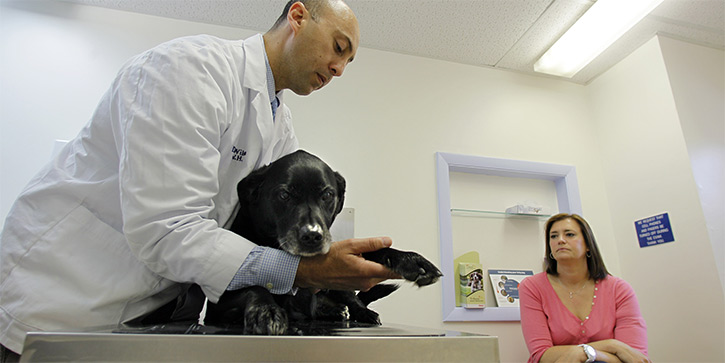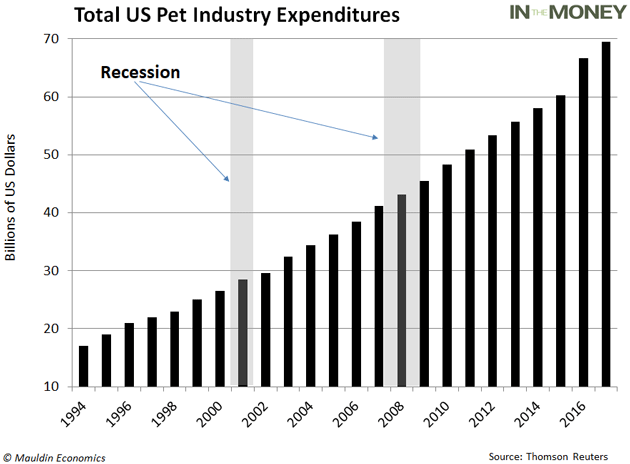
Profiting from America’s Pet Obsession
- Robert Ross
- |
- The Weekly Profit
- |
- June 26, 2019
Recession-proof industries are unique.
They sell stuff that people buy no matter what’s happening in the economy—things like electricity, internet access, toilet paper… and now pet care?
That’s right: America is pet obsessed.
Pet ownership is up. Spending on pets is up. In fact, we actually spend more on our pets during a recession.
We’ll dig into the details in a moment… and look at three companies in a niche of this recession-proof industry that can bolster your portfolio.
Most of Us Own Pets
Around 85 million US families own a pet, according to the National Pet Owners Survey. That’s 68% of US households.
This figure has increased around 2% annually since 2011. But spending on those pets has increased almost 7% annually.
Meanwhile, spending on veterinary care is growing especially fast. From 1991 to 2015, it shot from $4.9 billion to $35 billion. For perspective, that’s three times faster than US GDP grew over the same period.
And there’s more…
Pet care spending even grew during the last two recessions: 29% during the 2001 recession and 17% during the 2008–2009 recession.
You can see this in the next chart.

This all points to a solid, recession-proof industry.
It means pet care companies enjoy predictable cash flows and sales growth, even during a recession (something regular readers know I expect in the coming months).
It also means stable share prices for stockholders when they’re looking for it the most.
The “Dog Mom” Generation
There are demographic reasons behind the jump in pets and pet spending.
To start, US household formation is near all-time lows, according to Yardeni Research.
The main reason for this, says the Institute for Family Studies (IFS), is that millennials—born between 1980 and 2000—are marrying later. And they’re turning to pets for companionship.
Millennials make up 25% of the US population. But they own 35% of all pets, making them the largest pet-owning cohort in the country.
Aging baby boomers and empty nesters are also big pet fans.
In 2007, only 34% of adults over age 70 owned pets. But by 2016, the year boomers started turning 70, that figure had jumped to 41%.
As I write, fewer than half of the country’s 75 million baby boomers have reached their 70s. So the “dog mom” generation still has plenty of room to grow.
And these folks are spending a lot on their pets.
|
The Fastest Growing Area in Pet Care
Dog owners spend over $1,000 a year on Fido, on average. So companies that cater to these “dog moms” should continue to thrive.
Overall, spending on pets in the US has gone up every year since 1994. And it’s grown 4.6% annually over the last 10 years—or three-times faster than overall consumer spending.
This is good news for pet care companies. And it makes sense that they’ve done well, even during the last two recessions.
Pets are “part of the family” now. Their owners skimp on other things before downgrading to cheaper pet food or cutting back on supplies.
This is especially true for the $15 billion pet medication industry. Sure, you might skip your regular dog grooming appointment during a recession, but you’re not going skip your pet’s medication.
The booming pet medication market is proof positive of that. Pet medication sales are growing twice as fast as overall pet spending.
The pet medication market will be the highest growth area of the pet care industry for the next decade, reports market research firm Packaged Facts. It expects new products for flea and tick prevention as well as itch relief to drive sales.
And we can get a slice of that…
How to Profit from the Pet Health Market
We’ve been talking a lot about the coming recession here at The Weekly Profit.
For weeks, I’ve been warning readers that closely watched indicators like the yield curve inversion—also known as the Diamond Cross—and a bottoming employment rate are signaling a recession in the months ahead.
It’s probably not imminent. But it’s coming sooner rather than later.
That’s why we’re focusing on recession-proof dividend-paying stocks right now… to help you add safety and stability to your portfolio and prepare for this recession.
The pet health market is one way to do that.
One of my favorite pet health companies is PetMed Express Inc. (PETS). PetMed is a leading, nationwide pet pharmacy. The company markets over 3,000 prescription and non-prescription medications for dogs and cats directly to consumers.
PETS pays a hefty 6.7% dividend yield. It also has a low payout ratio. Shares have struggled a bit this year, but that also means they’re attractively priced right now—and a good way to take advantage of the growing pet health market.
Next on my list is Zoetis Inc. (ZTS). Zoetis used to be the animal health unit of Pfizer. The company is the largest manufacturer of anti-infectives, vaccines, and other animal health products in the world.
ZTS pays a small 0.6% dividend yield. However, with a 19% payout ratio, there’s plenty of room for the company to increase its dividend payout.
Lastly, we have Pets at Home Group PLC (PAHGF). The company operates a network of stores, pet services, and veterinary services in the United Kingdom.
The company pays a high 4.2% dividend yield. At 125%, the payout ratio is higher than I would like. But the company has very low debt and strong free cash flow. So it isn’t likely to cut the dividend, despite the high payout ratio.
Remember, this recession probably isn’t coming tomorrow. But it’s still important to buoy your portfolio now.
You want to buy recession-proof companies when you can, not when you need to. And now is the perfect time to add some dividend-paying pet health companies to your portfolio.

Robert Ross

